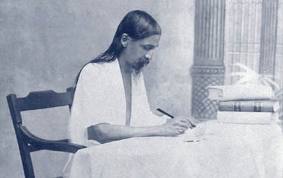
Each month we take a question of this nature and present an answer based on the writings of Sri Aurobindo and the Mother, with the belief that this could be of help to a larger number of persons. We welcome further comments on making our endeavour beneficial to all.
We all know that true Concentration plays a very important role in yoga. But we do not know exactly what role it plays.
The question arises:
“What is the meaning of Concentration? How is it used in ordinary life? How is it different when applied to Yoga? What is its importance in Yoga?”
Here is an excerpt from a letter of Sri Aurobindo which looks at these questions:
Concentration in Ordinary Life
Ordinarily the consciousness is spread out everywhere, dispersed, running in this or that direction, after this subject and that object in multitude. When anything has to be done of a sustained nature the first thing one does is to draw back all this dispersed consciousness and concentrate. It is then, if one looks closely, bound to be concentrated in one place and on one occupation, subject or object – as when you are composing a poem or a botanist is studying a flower. The place is usually somewhere in the brain, if it is the thought, in the heart if it is the feeling in which one is concentrated.
Yogic Concentration
The yogic concentration is simply an extension and intensification of the same thing. It may be on an object as when one does Tratak on a shining point – then one has to concentrate so that one sees only that point and has no other thought than that. It may be on an idea or word or a name, the idea of the Divine, the word OM, the name Krishna, or a combination of idea and word or idea and name.
But, further, in yoga one also concentrates in a particular place. There is the famous rule of concentrating between the eyebrows – the centre of the inner mind, of occult vision, of the will is there. What you do is to think firmly from there on whatever you make the object of your concentration or else try to see the image of it from there. If you succeed in this then after a time you feel that your whole consciousness is centred there in that place – of course for the time being. After doing it for some time and often it becomes easy and normal.
Concentration in Integral Yoga
In this yoga, you do the same, not necessarily at that particular spot between the eyebrows, but anywhere in the head or at the centre of the chest where the physiologists have fixed the cardiac centre. Instead of concentrating on an object, you concentrate in the head in a will, a call for the descent of the peace above or, as some do, an opening of the unseen lid and an ascent of the consciousness above. In the heart centre one concentrates in an aspiration, for an opening, for the presence of the living image of the Divine there or whatever else is the object. There may be Japa of a name but, if so, there must also be a concentration on it and the name must repeat itself there in the heart centre.
It may be asked what becomes of the rest of the consciousness when there is this local concentration? Well, it either falls silent as in any concentration or, if it does not, then thoughts or other things may move about, as if outside, but the concentrated part does not attend to them or notice. That is when the concentration is reasonably successful.
One has not to fatigue oneself at first by long concentration if one is not accustomed, for then it loses its power and value. One can relax and meditate instead of concentrating. It is only as the concentration becomes normal that one can go on for a longer and longer time.
Sri Aurobindo





